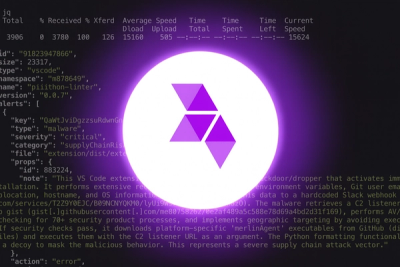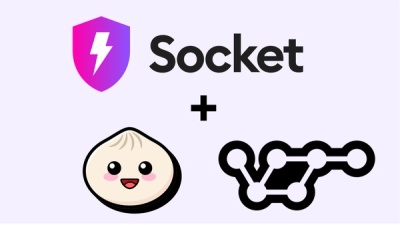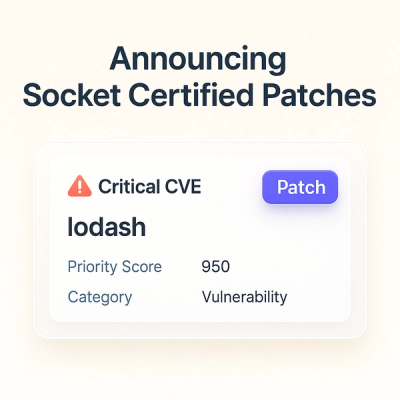
Product
Introducing Socket Scanning for OpenVSX Extensions
Socket now scans OpenVSX extensions, giving teams early detection of risky behaviors, hidden capabilities, and supply chain threats in developer tools.
pdf-invoice-spanish
Advanced tools
Simple yet powerful node JS library that generates PDF invoice on the fly.
Forked from https://github.com/h1dd3nsn1p3r/pdf-invoice

📑 Biblioteca JavaScript sencilla pero potente que genera facturas, presupuestos y recibos de pago en formato PDF a partir de datos JSON. Se puede utilizar en cualquier entorno Node JS/Bun JS.
via npm:
npm install @h1dd3nsn1p3r/pdf-invoice
via yarn:
yarn add @h1dd3nsn1p3r/pdf-invoice
via pnpm:
pnpm add @h1dd3nsn1p3r/pdf-invoice
Una vez instalado, puedes importarlo usando require or import:
const { PDFInvoice } = require('pdf-invoice-spanish');
or ES6 import:
import { PDFInvoice } from 'pdf-invoice-spanish';
PDFInvoice es una clase que toma la carga útil como argumento. La carga útil son los datos que desea mostrar en la factura. Para obtener más información, consulte el ejemplo Datos de la carga útil.
La estructura del Payload para los datos que desea mostrar en la factura. Es un objeto con la siguiente estructura:
const payload = {
company: {
logo: "<svg>...</svg>", // Optional. SVG logo of your company.
name: "Festrol Corp.",
address: "1711 W. El Segundo Blvd, Hawthorne, Canada - 90250",
phone: "Tel: (+11) 245 543 903",
email: "Mail: hello@festrol.io",
website: "Web: https://www.festrolcorp.io",
taxId: "Tax ID: 1234567890", // Optional.
},
customer: {
name: "John Doe",
company: "Xero Inc.", // Optional.
address: "1234 Main Street, New York, NY 10001",
phone: "Tel: (555) 555-5555",
email: "Mail: joe@example.com",
taxId: "Tax ID: 1234567890", // Optional.
},
invoice: {
number: 1721, // String or number.
date: "25/12/2023", // Default is current date.
dueDate: "25/12/2023", // Default is current date.
status: "Paid!",
currency: "€", // Default is "$",
path: "./invoice.pdf", // Required. Path where you would like to generate the PDF file.
},
items: [
{
name: "Cloud VPS Server - Starter Plan",
quantity: 1,
price: 400,
tax: 0, // Specify tax in percentage. Default is 0.
},
{
name: "Domain Registration - example.com",
quantity: 1,
price: 20,
tax: 0, // Specify tax in percentage. Default is 0.
},
{
name: "Maintenance Charge - Yearly",
quantity: 1,
price: 300,
tax: 0, // Specify tax in percentage. Default is 0.
},
],
qr: {
data: "https://www.festrolcorp.io",
width: 100, // Default is 50.
},
note: {
text: "Thank you for your business.",
italic: false, // Default is true.
}
};
Nota: Si la cadena es larga, puedes usar \n para dividir la línea. Por ejemplo:
const payload = {
company: {
name: "Festrol Corp.",
address: "1711 W. El Segundo Blvd, Hawthorne, \n Canada - 90250",
phone: "Tel: (+11) 245 543 903",
email: "Mail: email@yourcompany.com"
},
};
Entendamos cada uno de los campos de la carga útil.
Esta es la información sobre su empresa. Es un objeto con la siguiente estructura:
const company = {
logo: "<svg>...</svg>", // Optional. SVG logo of your company.
name: "Festrol Corp.", // Optional or required if logo is not supplied.
address: "1711 W. El Segundo Blvd, Hawthorne, \n Canada - 90250", // Optional.
phone: "Tel: (+11) 245 543 903", // Optional.
email: "hello@company.com", // Optional.
website: "Web: https://www.festrolcorp.io" // Optional.
taxId: "Tax ID: 1234567890", // Optional.
}
For now, only svg logo can be used. If you wish to use logo & do not want the company name, then do not pass the name field. Rest of the fields are optional.
### Invoice
This is the information about the invoice. It is an object with the following structure:
```js
const invoice = {
number: 1721, // Required.
date: "25/12/2023", // Optional. Default is current date.
dueDate: "25/12/2023", // Optional. Default is current date.
status: "Paid!", // Optional. Default is "Due pending!".
currency: "€", // Optional. Default is "$".
}
The invoice number is required. It might be a integer that you use to track your invoices. In most cases, it is a unique number that reference the order ID or invoice sequence number in your database. Rest of the fields are optional.
If path is supplied in the payload, then the PDF will be generated at that location. For example:
const file = "invoice" + "-#" + 1729 + "-" + new Date().getTime(); // invoice-#1729-1630480000000
const location = path.join(__dirname, "/invoices/" + file + ".pdf");
const invoice = {
path: location, // Required.
}
If path is not supplied in the payload, then the PDF will be generated in current working directory with the name invoice.pdf.
This is the information about your customer. It is an object with the following structure:
const customer = {
name: "John Doe", // Required.
company: "Xero Inc.", // Optional.
address: "1234 Main Street, New York, \n NY 10001", // Optional.
phone: "Tel: (555) 555-5555", // Optional.
email: "joedeo@example.com", // Optional.
taxId: "Tax ID: 1234567890", // Optional.
}
The name of the customer is required. Rest of the fields are optional.
Items are the products or services that you are selling. It is an array of objects with the following structure:
const items = [
{
name: "Cloud VPS Server - Starter Plan", // Required.
quantity: 1, // Required.
price: 400, // Required.
tax: 0, // Optional. Specify tax in percentage. Default is 0.
},
{
name: "Domain Registration - example.com", // Required.
quantity: 1, // Required.
price: 20, // Required.
tax: 0, // Optional. Specify tax in percentage. Default is 0.
},
{
name: "Maintenance Charge - Yearly", // Required.
quantity: 1, // Required.
price: 300, // Required.
tax: 0, // Optional. Specify tax in percentage. Default is 0.
},
];
The name, quantity and price of the item is required. Rest of the fields are optional. Although if you have single item in the invoice, you need to pass it as an object. For example:
const items = [
{
name: "Cloud VPS Server - Starter Plan", // Required.
quantity: 1, // Required.
price: 400, // Required.
tax: 0, // Optional. Specify tax in percentage. Default is 0.
},
];
If you want to add a QR code to the invoice, then you can use this field. It is an object with the following structure:
const qr = {
data: "https://www.festrolcorp.io/", // Required. The data that you want to encode in the QR code.
width: "100", // Optional. Default is 50.
}
The data field is required. It is the data that you want to encode in the QR code. The width field is optional. It is the width of the QR code in pixels. Default is 50. The recommended width of QR is 30 - 100.
Use this field if you want to add a note to the invoice. It is an string with the following structure:
const note = "Thank you for your business.";
Once you have the payload ready, you can generate the PDF using the following code:
const { PDFInvoice } = require('@h1dd3nsn1p3r/pdf-invoice');
const handleInvoice = async(): Promise<void> => {
const payload = {
// Prepare payload.
};
/**
* Create the invoice.
*/
const invoice = new PDFInvoice(payload);
const pdf = await invoice.create(); // Returns promise, await it.
console.log(pdf); // Full path to the PDF file.
}
handleInvoice();
Once you call the create method, it will return a promise. You can either use async/await or .then() to handle the promise. The create method will return the path to the PDF file if the PDF is generated successfully. Otherwise, it will throw an error.
If required you can change the configuration of the invoice. It is an object with the following structure:
All the text strings that are used in the invoice can be customized. For example:
const { PDFInvoice } = require('@h1dd3nsn1p3r/pdf-invoice');
const create = async(): Promise<void> => {
const payload = {
// ....
};
const config = {
// Custom labels.
string: {
invoice: "F A C T U A",
refNumber: "Referencia",
date: "Fecha",
dueDate: "Fecha de vencimiento",
status: "Estado",
billTo: "Facturar a",
item: "Artículo",
quantity: "Cantidad",
price: "Precio",
tax: "Impuesto",
total: "Total",
subTotal: "Subtotal",
totalTax: "Total Impuesto",
},
};
// Create the invoice.
const invoice = new PDFInvoice(payload, config);
const pdf = await invoice.create();
console.log(pdf);
}
Following are the fonts that are available build-in with the library:
All these three fonts includes regular, bold, italic and bold-italic styles. You can use them in the configuration object. For example:
const config = {
// ....
style: {
font: "Helvetica", // "Helvetica", "Times", "Courier"
fontSize: 10, // Optional. Default is 10.
lineHeight: 1.8, // Optional. Default is 1.8.
color: "#000000", // Optional. Default is black.
},
};
Any font can be used with the font option by passing the fonts TTF files path. For example:
const config = {
// ....
font: {
Noto: {
normal: path.join(__dirname, "fonts/noto/regular.ttf"),
italics: path.join(__dirname, "fonts/noto/italic.ttf"),
bold: path.join(__dirname, "fonts/noto/bold.ttf"),
bolditalics: path.join(__dirname, "fonts/noto/bold-italic.ttf"),
},
},
style: {
font: "Noto",
fontSize: 10, // Optional. Default is 10.
lineHeight: 1.8, // Optional. Default is 1.8.
color: "#000000", // Optional. Default is black.
},
};
If you need additional information do check the example. In the example, I have used "Noto" and the TTF files of Noto font are included in the fonts directory. If you have non-latin characters, then you can use any custom font that supports the characters.
This library is written in TypeScript. If you need to import the types, then you can import them from global.d.ts file. Refer to Global types file for more information.
Example:
import type { CompanyInfo, CustomerInfo, InvoiceInfo, ItemInfo, QRInfo, InvoicePayLoad } from '@h1dd3nsn1p3r/pdf-invoice/global.d.ts';
Refer to releases section for more information.
Pull requests are welcome. For major changes, please open an issue first to discuss what you would like to change.
FAQs
Simple yet powerful node JS library that generates PDF invoice on the fly.
We found that pdf-invoice-spanish demonstrated a not healthy version release cadence and project activity because the last version was released a year ago. It has 0 open source maintainers collaborating on the project.
Did you know?

Socket for GitHub automatically highlights issues in each pull request and monitors the health of all your open source dependencies. Discover the contents of your packages and block harmful activity before you install or update your dependencies.

Product
Socket now scans OpenVSX extensions, giving teams early detection of risky behaviors, hidden capabilities, and supply chain threats in developer tools.

Product
Bringing supply chain security to the next generation of JavaScript package managers

Product
A safer, faster way to eliminate vulnerabilities without updating dependencies